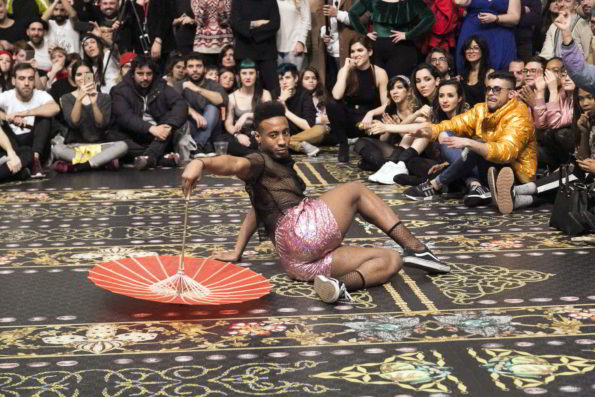Search
To search for an exact match, type the word or phrase you want in quotation marks.
A*DESK has been offering since 2002 contents about criticism and contemporary art. A*DESK has become consolidated thanks to all those who have believed in the project, all those who have followed us, debating, participating and collaborating. Many people have collaborated with A*DESK, and continue to do so. Their efforts, knowledge and belief in the project are what make it grow internationally. At A*DESK we have also generated work for over one hundred professionals in culture, from small collaborations with reviews and classes, to more prolonged and intense collaborations.
At A*DESK we believe in the need for free and universal access to culture and knowledge. We want to carry on being independent, remaining open to more ideas and opinions. If you believe in A*DESK, we need your backing to be able to continue. You can now participate in the project by supporting it. You can choose how much you want to contribute to the project.
You can decide how much you want to bring to the project.

‘A list of truths:
That dance jolts and wakes up all that is asleep.That the memory the body could be greater than that of the mind’.
Benji Hart, Dancer as Insurgent, CA2M, 2017
Reconverting identity through gestures. Elements of Vogue. A Case Study in Radical Performance has transformed CA2M into a ballroom, a space for triggering desire through dancing bodies. Vogue is the most popular form of dance in the ballroom scene that flourished in New York in the early eighties, the response of the lesbian, gay, transsexual, bisexual and queer (LGTBQ) Afro-American community to the AIDS crisis, yet its roots date back to the decade of the twenties during the Harlem Renaissance.
The exhibition meaningfully opens with D’relle Khan, Bam Bam Garçon and Jay Jay Revlon, dancers from the London vogue scene dancing improvisationally on the streets in solidarity with the victims of the homophobic terrorist attack at a club in Orlando in 2016. From the very beginning, the bodies, gestures, poses and community generated by the event feature prominently in a show that presents a large number of contemporary Afro-American artworks in Europe for the first time. The ensemble of works – from the recording of queer and drag dances, to the activism of Sylvia Rivera and Martha P. Johnson, not to mention historical figures of Afro-American performance such as Adrian Piper – tells the story of the dissident gestures of the Afro-American LGTBQ community and reveals how their appropriation enables the invention of dissident forms of beauty, subjectivity and desire.
At all times, the parade appears as a tool of empowerment through which gender binarism ceases to exist, replaced by particular gestures that anyone can adopt and feature more prominently in the activities organised around the exhibition that have drawn the racialised and LGBTQ communities to CA2M. Vogue forms a part of the activities around the King of Arms Ballroom Installation by Rashaad Newsome, displayed in a new museum space that seems to have been created deliberately for the show by architect Andrés Jaque. The activity programme, designed by Silvi ManneQueen, a trailblazer of vogue in Spain, has organised several workshops where the basic steps of the different ballroom dances such as Runway, Realness or Vogue Performance are taught, bringing other vogue icons from New York, Moscow and Paris — the European city where ballroom culture is more consolidated. The OVAH Ball, programmed for the exhibition’s closing night on 6 May, will feature dances in several categories with Parisian commentator Matyouz LaDurée and three key voguers from the New York scene — Twiggy Pucci Garçon, Mother Leoimy Amazon, Archie Burnett and Javier Ninja.
I realise that I’m writing this article the same week that the Centro de Arte Dos de Mayo (CA2M) is celebrating its tenth anniversary. I think it’s no coincidence that such a groundbreaking exhibition that will certainly enhance gazes and raise body awareness should be hosted at the centre. CA2M has a long history of addressing popular culture from the field of contemporary art, as proved by the shows Pop Politics: Activism at 33 Revolutions (2012-2013) and Punk. Its Traces in Contemporary Art (2015). The appointment of Manuel Segade as director in 2016 has entailed the politicisation of the exhibition programme based on the intersections between gender, race and social class. The shows entitled Cabello/Carceller: Draft for An Untitled Exhibition [Chapter II] (2017) and A Choreographed Exhibition (2017) – the latter curated by Mathieu Copeland – foreshadowed this turn to bodies, on the one hand, and to projects based on feminist, queer and decolonial theories, on the other. Elements of Vogue, therefore, brings into play the intersectionality defended by Segade. The show is co-curated by Sabel Gavaldon, who had previously carried out research on gestures as spaces of resistance in the exhibition entitled A Museum of Gesture (2013) staged at La Capella in Barcelona.

Marta Sesé researches and writes abour contemporary art. She lives in Madrid and works in arts publishing. She also co-manages the project Higo Mental: www.higomental.com
"A desk is a dangerous place from which to watch the world" (John Le Carré)